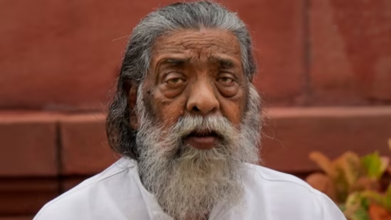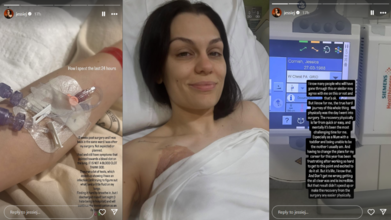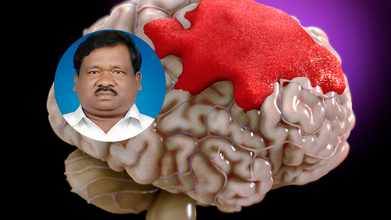- Health Conditions A-Z
- Health & Wellness
- Nutrition
- Fitness
- Health News
- Ayurveda
- Videos
- Medicine A-Z
- Parenting
- Web Stories
Former Jharkhand CM Shibu Soren Passes Away After a Month on Life Support: What Does It Truly Mean to Be on Life Support?

(Credit-PTI)
At the age of 81, the former Jharkhand chief minister Shibu Soren passed away on Monday 4th August morning. The founder of Jharkhand Mukti Morcha was famously known as "guruji" and had been in the hospital for the past whole month. He had been suffering from a kidney-related ailment as well as a stroke.
His son Jharkhand Chief Minister Hemant Soren confirmed the death in a social media post on X saying: “Respected Guru Dishom has left us all. Today, I have become empty.”
We spoke to Dr. Raghavendra Ramanjulu, Lead Consultant in Aster CMI Hospital to understand the nuances of supported living.
What Does It Mean To Be On Life Support?
Life support is a variety of medical treatments that keep a person alive when their body can't function on its own. These treatments support or replace a failing body part until the body can recover.
Dr. Ramanjulu explains “Doctors suggest life-support for a patient when the body is no longer able to perform essential functions on its own like breathing, maintaining blood pressure, or keeping the heart beating. This often occurs in extreme medical situations such as traumatic injuries, severe infections, heart attacks, strokes, or advanced stages of chronic illness.”
Life support is a serious decision made after doctors have carefully checked the patient's condition and talked with their family. Sometimes it's used for a short time to give the body a chance to heal, while other times it's a bridge to making long-term decisions about care.
It’s important to understand that being on life support doesn't mean a person is dying, but sometimes the body never fully recovers and needs continued support.
When Is Life Support Started Or Stopped Entirely?
Life support is started as soon as a person’s body needs it, but it won't be started if the person has already said no. This can be done verbally, in writing through legal documents, or by family members making the decision for them. Doctors will also not start life support if there is no medical benefit, such as when a treatment would only prolong suffering.
You can be on life support for a long time. Doctors and family members may decide to stop it if there is little chance of a person having a meaningful recovery. It’s legally and ethically okay to end treatments that are no longer helping. It's crucial to remember that death is caused by the underlying illness, not by the decision to stop treatment.
Life-Support Aren’t Permanent or Last Decisions Only
Dr. Ramanjulu described an unforgettable experience about a young man who was put on life support after a severe accident. For days, his condition was very serious, and his family worried he wouldn't make it. The machines kept him alive while the doctors worked nonstop. Slowly, his body began to improve, and he eventually started breathing on his own without the ventilator. Watching him leave the ICU, sitting up and smiling, was a deeply moving moment for everyone. It was a powerful reminder that even in the toughest situations, the human body can surprise us with its will to survive and heal.
What Organs Are Still Active on Life Support?
Dr. Ramanjulu explains that when a person is on life support, some of their organs may still be working on their own, while others are being helped by machines. For example, a ventilator will breathe for the lungs, while the kidneys might still work partially. The brain might also remain active, depending on the injury.
Life support doesn't mean the body has completely stopped working; it just means some vital systems are too weak to function without help. The medical team closely monitors which organs are active, as any sign of natural function offers hope for recovery.
Common Types of Life Support
Life support includes more than just ventilators. It covers any medical procedure that keeps the body running. Here are some of the different types:
Mechanical Ventilation
A machine called a ventilator helps you breathe by pushing air into your lungs through a tube. This is used for short-term problems or long-term if a person has irreversible breathing failure.
ECMO (Extracorporeal Membrane Oxygenation)
This is a more advanced machine that acts as your lungs, adding oxygen and removing carbon dioxide directly from your blood before pumping it back into your body.
CPR (Cardiopulmonary Resuscitation)
CPR is a series of treatments like chest compressions and electric shocks used when a person's heart and breathing stop. It can be life-saving for sudden events but is rarely successful for those with a terminal illness.
AED (Automated External Defibrillator)
A portable device that delivers an electric shock to help a heart with an irregular rhythm return to normal.
Artificial Nutrition and Hydration
This involves giving a person nutrients and fluids through a tube. It can be life-saving until the body heals, but for long-term use with a terminal illness, it may not improve a person’s quality of life.
Kidney Dialysis
A machine that filters waste and extra fluid from the blood when the kidneys are not working. For many, this improves their quality of life, but for others with a terminal condition, the burdens may outweigh the benefits.
World's First Gonorrhea Vaccine Programme Rolled Out By NHS

(Credit-Canva)
A new vaccine to protect against gonorrhea is now available at sexual health clinics across England. This is a big step in the fight against a serious and fast-spreading sexually transmitted infection (STI). The vaccine is being offered to people who are at the highest risk of getting gonorrhea.
This includes gay and bisexual men who have recently had multiple sexual partners and another bacterial STI within the last year. This new program is expected to protect thousands of people and save the NHS over £7.9 million in the next decade. This is part of the government's new approach to healthcare, which focuses on stopping illnesses before they start, rather than just treating them after.
Who Is Eligible for the Vaccine?
The vaccine being used, called 4CMenB, was originally created to prevent a type of meningitis. However, doctors have found that it also works against gonorrhea. This is great news because gonorrhea cases have been on the rise, reaching a record high of 85,000 in England last year—three times higher than in 2012. By offering this vaccine, health officials hope to prevent up to 100,000 cases of gonorrhea over the next ten years.
This vaccine is also important for another reason: it helps fight the growing problem of antibiotic-resistant strains of the disease. By preventing infections, it reduces the need for antibiotics, which helps keep those medicines effective for everyone. This new program will also take some pressure off busy NHS services.
Increasing Risk Of Gonorrhea
UK Health Security Agency had previously raised concerns with the increase in cases of antibiotic-resistant gonorrhea. While most gonorrhea infections are still easily cured with a common antibiotic called ceftriaxone, some new strains are becoming much harder to treat.
Since 2015, there have been 42 cases of gonorrhea that are resistant to ceftriaxone. What's even more concerning is that 15 of these cases were extensively drug-resistant (XDR), meaning they were also resistant to the second-choice treatments.
These resistant cases are becoming more frequent. In the last year, there have been more resistant cases than in the previous two years combined. Most of these infections are linked to people traveling to and from the Asia-Pacific region, where this type of resistance is more common. While these cases are still rare in England, the increasing number raises the risk of wider spread.
Gonorrhea often has no symptoms, especially in the throat or in the vagina. When there are symptoms, they can include a thick yellow or green discharge, pain during urination, and pain in the lower abdomen. If left untreated, gonorrhea can lead to serious health problems like infertility and pelvic inflammatory disease (PID). The best ways to protect yourself are:
- Use condoms during sex.
- Get tested regularly if you have had unprotected sex with new or casual partners. Testing is free, confidential, and can be done at local sexual health clinics or with a home testing kit.
How Vaccine Impacts Broader Prevention Strategy?
The new gonorrhea vaccine is just one part of a bigger plan to improve public health in England. Public Health Minister Ashley Dalton urges anyone who is eligible to get the vaccine, pointing out that it protects not only themselves but also their sexual partners.
Dr. Sema Mandal, an expert from the UK Health Security Agency, says in the press release that this vaccine is very welcome, especially because of the worrying rise in antibiotic-resistant gonorrhea. She also mentioned that sexual health clinics will continue to offer other important vaccines for mpox, hepatitis A and B, and HPV, giving people a lot of protection against a range of STIs.
Dr. Amanda Doyle, from the NHS adds in and shares that the vaccine rollout a "real step-forward for sexual health." She strongly encouraged everyone who is eligible to get all the recommended vaccines to stay safe and help protect others.
Jessie J Health Update: Hospitalized Weeks After Cancer Surgery Due To Lung Infection

Credits: Canva
Six weeks after undergoing breast cancer surgery, singer Jessie J revealed that she was unexpectedly hospitalized again, this time due to a suspected lung issue. The 37-year-old artist, known for her chart-topping hits like Price Tag and Domino, shared that she returned to the same hospital ward where she had recovered post-surgery.
In an emotional update on Instagram, she wrote: “Six weeks post-surgery and I was back in the same ward I was after my surgery. Not expected or planned.”
Doctors initially suspected a blood clot in her lung due to concerning symptoms, but further tests ruled that out. Instead, they discovered she had an infection and a small amount of fluid in her lungs. The exact source of the infection is still being investigated.
Despite ongoing symptoms and difficulty breathing, Jessie J said she chose to discharge herself from the hospital: “I hate being in hospital and will continue the investigation as an outpatient.”
What Happened To Her?
The singer said she was experiencing troubling symptoms that hinted at a pulmonary embolism. “I had and still have symptoms that pointed towards a blood clot on the lung. IT IS NOT A BLOOD CLOT THANK GOD,” she shared. “They ran a lot of tests, which ended up showing I have an infection (still trying to figure out what) and a little fluid on my lungs.”
In the post, she also included a photo showing a cannula inserted in her arm, highlighting the seriousness of her condition and the fatigue that comes with recovery.
Adjusting to a Slower Recovery
The singer underwent a mastectomy and breast reconstruction surgery after being diagnosed with early-stage breast cancer earlier this year. In July, she had celebrated the news that there was no sign of cancer spread.
However, her latest update highlights the emotional and physical toll of recovery. “The recovery physically is far from quick or easy,” she said. “And mentally, it’s been the most challenging time for me, especially as a mum with a toddler and being unable to be the mother I usually am.”
Jessie J welcomed her son, Sky Safir Cornish Colman, in 2023 after previously experiencing a miscarriage in 2021. She has been open about the complexities of motherhood alongside serious health challenges.
Impact on Career and Mental Health
The star also spoke about the career setbacks caused by her ongoing health issues. “Having to change the plans for my career for this year has been frustrating after working so hard to get to this point and excited to do it all. But it’s life. I know that,” she admitted.
She said that while getting the all-clear from cancer was “incredible,” it didn’t make the physical healing from surgery any easier. The reality, she added, is that recovery takes time and patience.
A Reminder to Slow Down
Known for her high-energy performances and fierce work ethic, Jessie J described the shift in pace as a tough adjustment. “As an ADHD Aries, fire-breathing dragon T-Rex, I can do it myself, I’m always ok woman. That slow pace has been a hard reality to accept to be honest,” she wrote.
Despite the frustrations, she acknowledged that this health scare served as a wake-up call. “This isn’t a speedy recovery, and it isn’t meant to be,” she said. “It’s a reminder to myself to slow down, even though I felt I already was.”
Jessie J's History of Health Battles
This isn’t Jessie J’s first experience with serious health issues. Diagnosed with a heart condition at the age of eight, she suffered a minor stroke at 18 and temporarily lost hearing in 2020. Yet despite her setbacks, the Brit Award-winning artist has remained candid about her health journey and determined to keep going.
Jharkhand Education Minister Ramdas Soren Suffers Brain Hemorrhage, Airlifted To Delhi

Credits: Canva
Jharkhand Education Minister Ramdas Soren remains in critical condition after suffering a severe brain injury following a fall in the bathroom at his residence early Saturday morning.
According to officials, the minister was initially admitted to a hospital in Jamshedpur, where doctors detected a blood clot in his brain. He was later airlifted to a private hospital in Delhi for more advanced treatment.
Health Minister Irfan Ansari confirmed the incident and said that Soren’s condition deteriorated rapidly after the fall. “Ramdas Soren’s health suddenly declined. He suffered a serious brain injury and internal bleeding in the brain. I have been in constant touch with his family and am monitoring the situation closely,” Ansari said.
Airlifted to Delhi for Advanced Care
After initial treatment in Jamshedpur, the decision was made to transfer the minister to Delhi for more specialized care. Former Union Minister and senior BJP leader Arjun Munda, who was present at Sonari Airport during the airlift, said, “I have spoken to the director of Delhi Apollo Hospital, and he has assured that treatment will begin as soon as the minister reaches. The doctors have diagnosed a brain hemorrhage due to a sudden increase in pressure. His condition is critical, but we are hopeful.”
On Saturday evening, the Delhi hospital issued a statement confirming that the minister was on life support and under the care of a multidisciplinary team of senior specialists. “A close watch is being kept on all vital parameters,” a spokesperson for the hospital said.
Understanding Brain Hemorrhage: What Happened to Ramdas Soren?
A brain hemorrhage, commonly known as a brain bleed, occurs when there is bleeding either inside the brain tissue or in the space between the brain and the skull. It is a medical emergency that can cause damage by increasing pressure on the brain, reducing oxygen supply, and killing brain cells.
Doctors categorize brain hemorrhages based on where the bleeding occurs:
Bleeding Outside Brain Tissue (Within Skull)
Epidural Hemorrhage: Occurs between the skull and the outer membrane (dura mater)
Subdural Hemorrhage: Bleeding between the dura mater and the arachnoid membrane
Subarachnoid Hemorrhage: Bleeding between the arachnoid and the innermost membrane (pia mater)
Bleeding Inside Brain Tissue
Intracerebral Hemorrhage: Bleeding within the brain’s tissues
Intraventricular Hemorrhage: Bleeding into the brain’s internal cavities that hold cerebrospinal fluid
In Soren’s case, doctors suspect a form of intracerebral or subdural hemorrhage, given the mention of clotting and pressure build-up.
Symptoms and Risks
Brain bleeds can come on suddenly and include symptoms like severe headache, nausea, vomiting, confusion, weakness or numbness (especially on one side of the body), vision problems, dizziness, seizures, slurred speech, and even coma. A particular warning sign is the so-called “thunderclap headache”, a sudden, intense pain that can signal a subarachnoid hemorrhage.
When not treated immediately, such bleeds can be fatal or lead to long-term neurological complications. In some cases, surgery is required to relieve pressure and remove clots.
What’s Next?
As of Saturday night, Ramdas Soren continues to remain on life support. No additional medical bulletins have been released since his transfer to Delhi, but officials have indicated that his condition is still being evaluated. “We are hoping for positive progress, but his condition remains critical,” said Arjun Munda.
Family members and close colleagues are at the hospital, and the Jharkhand government has said it will provide all necessary support for his treatment.
The political and public community has expressed concern and extended wishes for the minister’s speedy recovery. Further updates are awaited from the hospital and health authorities.
© 2024 Bennett, Coleman & Company Limited

